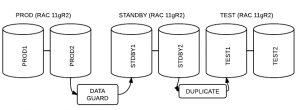#!/usr/bin/php -f
< ?php
define('WD','/opt/oracle/awr');
$cs = $_SERVER['argv'][1];
$user = 'mymonitoruser';
$pass = 'mystrongpassword';
/* open a new connection */
$ds = oci_connect($user, $pass, $cs)
or die ("Cannot connect to Oracle Database ".$cs."\n");
/* setting client nls environment */
$sql = "alter session set nls_timestamp_format='MM/DD/YY HH24:MI'";
$stmt = oci_parse($ds, $sql);
oci_execute($stmt);
oci_free_statement($stmt);
/* create directory that will contain rrds (if not exists) */
if(!file_exists(WD.'/'.$cs))
mkdir(WD.'/'.$cs);
if(!file_exists(WD.'/'.$cs.'/wait'))
mkdir(WD.'/'.$cs.'/wait');
/* function to create new RRDs */
function createRRD($name, $interval, $cs) {
$hb = $interval*5; //heartbeat
$cmd="rrdtool create ".WD."/".$cs."/wait/${name}.rrd -s ".$interval." \
-b \"now -3month\" DS:waits:DERIVE:$hb:0:U \
DS:mswaited:DERIVE:$hb:0:U \
RRA:AVERAGE:0.5:1:1440 RRA:AVERAGE:0.5:30:336 \
RRA:AVERAGE:0.5:120:372 RRA:AVERAGE:0.5:720:730 \
RRA:MIN:0.5:1:1440 RRA:MIN:0.5:30:336 \
RRA:MIN:0.5:120:372 RRA:MIN:0.5:720:730 \
RRA:MAX:0.5:1:1440 RRA:MAX:0.5:30:336 \
RRA:MAX:0.5:120:372 RRA:MAX:0.5:720:730 \
RRA:LAST:0.5:1:1440";
//print $cmd."\n";
return passthru($cmd);
}
/* take the snapshot frequency from dba_hist_wr_control
to create the RDD with correct heartbeat value */
$sql = 'select extract(hour from snap_interval)*3600 +
extract(minute from snap_interval)*60 as SEED from DBA_HIST_WR_CONTROL';
$stmt = oci_parse($ds, $sql);
oci_execute($stmt);
$row = oci_fetch_assoc($stmt);
$interval = $row['SEED'];
unset($row);
oci_free_statement($stmt);
/* statement definition that will collect
all snapshots for a certain wait event with more than
a certain amonut of time waited.
Gathering ALL EVENTS could be time consuming and useless.
I fetch rows ordered by event_name rather
then by date because I can update many values
into the same rrd with very few rrdupdate commands
*/
$sql = 'select s.END_INTERVAL_TIME END_INTERVAL_TIME,
g.EVENT_NAME, g.WAIT_CLASS, g.TOTAL_WAITS,
round(g.TIME_WAITED_MICRO/1000) MS
from DBA_HIST_SNAPSHOT s,
dba_hist_bg_event_summary g,
v$instance i
where s.SNAP_ID=g.SNAP_ID and g.wait_class!=\'Idle\'
and g.TIME_WAITED_MICRO>100000
and s.instance_number=i.instance_number
and s.instance_number=g.instance_number
order by 2,1';
/* default prefetch size (148) matches default snapshot retention (24hx7dd) */
$stmt = oci_parse($ds, $sql);
oci_set_prefetch($stmt, 148);
oci_execute($stmt);
$i=0;
$oldevent="";
while ($row = oci_fetch_assoc($stmt)) {
if ($oldevent != $row['EVENT_NAME']) {
//NEW EVENT DETECTED: WILL START A NEW UPDATE CMD
if ($i != 0 && !empty($cmd)) {
/* not the first occurrence,
I bet there's something in my buffer */
passthru($cmd);
}
$cleanName = preg_replace ("([^[:alnum:]_-])","_",$row['EVENT_NAME']);
// if there is no rrd for this event, I create a new one
if (!file_exists(WD."/".$cs."/wait/${cleanName}.rrd")) {
createRRD($cleanName, $interval, $cs);
}
/*
* I initialize a new update command. This string act as a buffer: I append many
* values to be updated so I'll update many values in a single command line:
* less forks of rrdtool and less file opens: the whole update process has an
* enormous improvement.
*/
$precmd="rrdtool update ".WD."/".$cs."/wait/${cleanName}.rrd ";
$lastcmd="rrdtool info ".WD."/".$cs."/wait/${cleanName}.rrd".
"| grep last_update | awk '{print \$NF}'";
$last=trim(`$lastcmd`);
printf ("%s - %s - last: %d\n", $row['EVENT_NAME'], $cleanName, $last);
$i=0;
$cmd=$precmd;
$oldevent=$row['EVENT_NAME'];
}
$time=strtotime($row['END_INTERVAL_TIME']);
//print "time: ".$time." last: ".$last."\n";
if ( $time > $last ) {
$cmd.=" ".$time.":".$row['TOTAL_WAITS'].":".$row['MS'];
$i++;
}
if ($i >= 40) {
// when I reach 40 values per commandline I force
// the update: next loop will reinitialize a new commandline.
passthru($cmd);
$cmd=$precmd;
$i=0;
}
unset($row);
}
if ($i != 0) {
/* one more update pending in my buffer */
passthru($cmd);
}
oci_free_statement($stmt);
oci_close($ds);
?>



